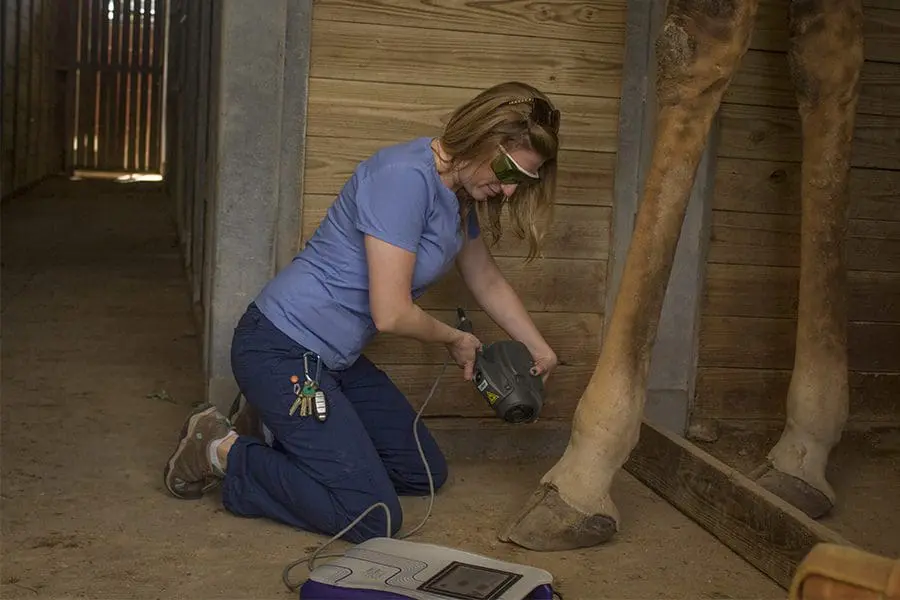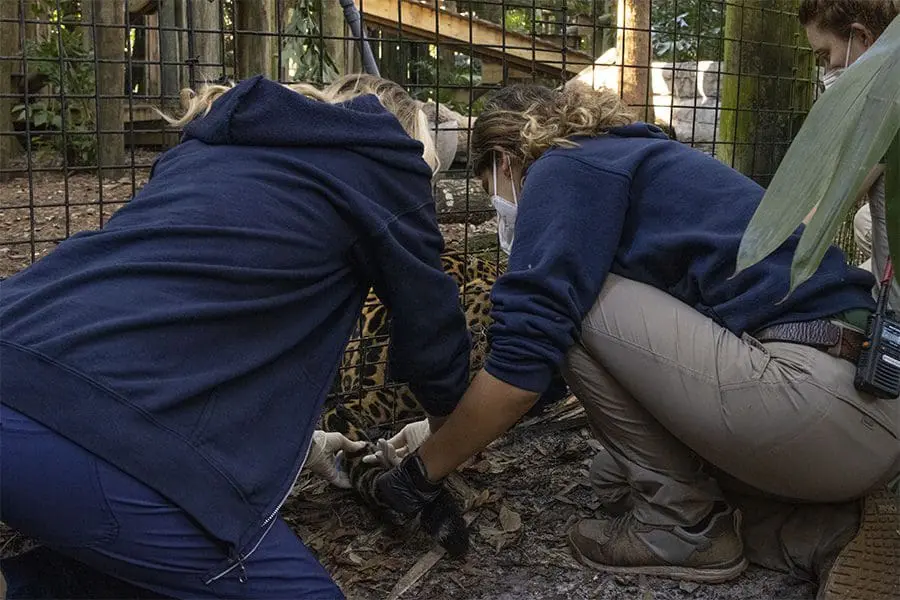

Mulac is fed yummy treats while his keepers prepare him for a voluntary blood draw.
Editor’s Note: Since the publishing of this post, we made the compassionate, but difficult decision to euthanize Mulac to prevent future suffering. The quality of life assessments (QLAs) discussed in more detail in the post below, helped us assess that Mulac’s quality of life was severely deteriorating due to his arthritis. Saying goodbye to such a cherished resident was especially tough for our Zoo community.
With over 900 animals at the Zoo, our staff works hard to ensure that each and every resident receives the best possible care. From tiny beach mice to giant giraffes, our veterinary and animal teams have individual wellness plans for every species. But what happens when an animal grows older?
Providing Lifelong Care
Animals at zoological or aquarium facilities tend to live longer than their wild counterparts for a variety of reasons including lack of predators and advancements in animal husbandry, medicine and nutrition. We look to studbooks managed by the Association of Zoos and Aquariums (AZA) Species Survival Plans (SSPs) to assess the life expectancies of our residents and consider an animal “geriatric” once they reach around 80% of their expected lifespan.
As part of our preventative approach to care, our veterinary team performs routine exams on all Zoo animals to detect potential illnesses before they start to affect an animal’s welfare, or wellbeing. For our older residents, we also perform regular quality of life assessments (QLAs), which allow us to evaluate an individual’s quality of life by monitoring things like ongoing health issues, current medications and objective measures such as mobility, hygiene and good vs. bad days. The data generated by the QLAs allows us to track each older animal over time and make the best possible decisions for them.
“It is our main priority to give lifelong care to our animals,” said Ellen Dreyer, the Zoo’s Behavioral Husbandry and Wellness Coordinator. “This oftentimes means modifying habitats, diets, enrichment and medical care as our residents’ needs change over the course of their lives.”
Managing Ability Changes in a Natural Way
In addition to age-related diseases and dental issues, arthritis is a common issue we manage in our older patients. To help these individuals maintain the best quality of life, we use a combination of techniques to help including modifying their habitat to make it easier for them to get around by installing ramps or changing the placement of their food.
Our 23-year-old bull giraffe Rafiki has developed arthritis in his hooves, so Expedition Africa keepers have trained Rafiki to voluntarily station (or stand in place while keepers feed him snacks). Our veterinary team can then perform laser therapy on his hooves to alleviate the arthritis. The laser does not hurt him.

Veterinary technician Kristi takes care of Rafiki’s hooves using laser therapy.
Rafiki has also been coached to lift his feet to have his hooves trimmed, which is something all our giraffes are taught to do, but we use a modified hoof block to make the experience more comfortable for this big guy. If you’ve ever been on the Expedition Africa platform wondering where he is, Rafiki’s keepers have offered him the option of whether he would like to be on habitat each day, which means he can choose to stay in a behind-the-scenes barn area during the day. This allows him to rest his hooves—but don’t worry, keepers still give him lots of attention! Our team monitors his mobility daily and has switched out the substrate in the barn to an option that cushions his joints.
A Preventative Approach to Veterinary Care
Our veterinary team learned of 20-year-old jaguar Mulac’s kidney disease before he ever started showing signs of illness. Thanks to our preventative approach to veterinary care, we were able to start Mulac on medications and adjust his diet to combat the disease. Keepers have trained the jaguar to participate in voluntary monthly blood draws to monitor his condition—he of, course, gets lots of yummy treats during this process. We also check his urination regularly and give daily “ice pops” to help with water consumption.

Veterinary and keeper staff work together to draw blood from Mulac’s tail while he enjoys a tasty treat.
Our commissary and veterinary departments also work together to adjust the diets of arthritic animals, such as Mulac and Rafiki, to ensure they are at both an ideal body weight and a weight that limits the stress on their joints.
We are fortunate to be home to quite a few geriatric animals who have surpassed the lifespan for their species in their natural range thanks to our care. We also credit this to our use of QLAs to monitor the physical, mental and emotional health of our animals. These assessments can be done at any frequency, but typically when residents begin showing signs of advanced age, we will begin them with monthly QLAs and increase the frequency as their issues progress (this could be bi-weekly, weekly or even daily).
“The QLAs are not just for geriatric animals,” said Ellen. “These assessments are very helpful for us to determine trends in any animals’ health. If we see an older animal’s QLA scores dip lower, it is a signal for us to make adjustments to keep that animal comfortable, whether that means changes to their habitat, day-to-day activities or medications.”
These assessments also help us determine when euthanasia is the most humane option for an animal whose quality of life has taken a significant downturn. These incredibly tough end-of-life decisions are made by a team that includes veterinary staff, zookeepers and animal curators. We want to give the most considerate care possible to animals at all stages of their lives, which includes those at the end. Our staff, especially our keepers, form close bonds with our residents in the course of giving them daily care. Their close relationships make these decisions especially bittersweet.
“Although end-of-life care can be tough, it’s ultimately a part of our jobs,” said Ellen. “We strive to make the most compassionate decisions possible to give the animals who call our Zoo home the best quality of life.”
Brevard Zoo is an independent, not-for-profit organization that receives no recurring government funding for our operating costs. Your generous support enables us to continue to serve our community and continue our vital animal wellness, education and conservation programs.